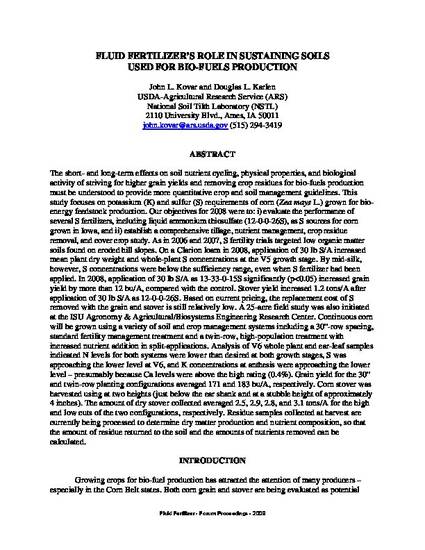
Fluid Fertilizer, Forum Proceedings, 2009
The short- and long-term effects on soil nutrient cycling, physical properties, and biological activity of striving for higher grain yields and removing crop residues for bio-fuels production must be understood to provide more quantitative crop and soil management guidelines. This study focuses on potassium (K) and sulfur (S) requirements of corn (Zea mays L.) grown for bioenergy feedstock production. Our objectives for 2008 were to: i) evaluate the performance of several S fertilizers, including liquid ammonium thiosulfate (12-0-0-26S), as S sources for corn grown in Iowa, and ii) establish a comprehensive tillage, nutrient management, crop residue removal, and cover crop study. As in 2006 and 2007, S fertility trials targeted low organic matter soils found on eroded hill slopes. On a Clarion loam in 2008, application of 30 lb S/A increased mean plant dry weight and whole-plant S concentrations at the V5 growth stage. By mid-silk, however, S concentrations were below the sufficiency range, even when S fertilizer had been applied. In 2008, application of 30 lb S/A as 13-33-0-15S significantly (p<0.05) increased grain yield by more than 12 bu/A, compared with the control. Stover yield increased 1.2 tons/A after application of 30 lb S/A as 12-0-0-26S. Based on current pricing, the replacement cost of S removed with the grain and stover is still relatively low. A 25-acre field study was also initiated at the ISU Agronomy & Agricultural/Biosystems Engineering Research Center. Continuous corn will be grown using a variety of soil and crop management systems including a 30”-row spacing, standard fertility management treatment and a twin-row, high-population treatment with increased nutrient addition in split-applications. Analysis of V6 whole plant and ear-leaf samples indicated N levels for both systems were lower than desired at both growth stages, S was approaching the lower level at V6, and K concentrations at anthesis were approaching the lower level – presumably because Ca levels were above the high rating (0.4%). Grain yield for the 30” and twin-row planting configurations averaged 171 and 183 bu/A, respectively. Corn stover was harvested using at two heights (just below the ear shank and at a stubble height of approximately 4 inches). The amount of dry stover collected averaged 2.5, 2.9, 2.8, and 3.1 tons/A for the high and low cuts of the two configurations, respectively. Residue samples collected at harvest are currently being processed to determine dry matter production and nutrient composition, so that the amount of residue returned to the soil and the amounts of nutrients removed can be calculated.
Available at: http://works.bepress.com/douglas_karlen/63/
